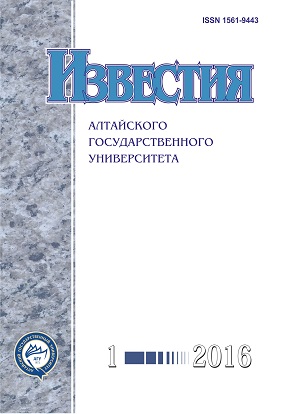On the Levi Class Generated by the Almost Abelian Quasivariety of Nilpotent Groups
Abstract
For an arbitrary class of groups M we denote by L(M) the class of all groups G in which the normal closure of every element of G belongs to M. The class L(M) is called the Levi class generated by M. A study of Levi classes should be considered as a step towards studying the structure of groups covered by a system of normal subgroups. Levi classes were introduced under the influence of Levi’s article in which Levi gave the classification of groups with abelian normal closures. R.F. Morse proved that if the class M is a variety of groups then L(M)is also a variety of groups. It follows from the works of A.I. Budkin that if M is a quasivariety, then L(M) is a quasivariety of groups, too. We consider that the quasivariety qH2 is generated by the relatively free group in the class of nilpotent groups of length at most 2 with the exponent commutant of 2. Earlier we found descriptions of the Levi classes generated by the almost abelian quasivarieties of nilpotent groups (i.e. the nonabelian quasivarieties of nilpotent groups in which all proper subquasivarieties are abelian) except L(qH2). In this paper, we continue to explore the Levi classes generated by the almost abelian quasivarieties of nilpotent groups. It is proved that the class L(qH2) contains the nilpotent group of lenght 3.
DOI 10.14258/izvasu(2016)1-26
Downloads
Metrics
References
Kappe L.C. On Levi-formations // Arch. Math. — 1972. — V. 23, № 6.
Levi F.W. Groups in which the commutator operation satisfies certain algebraic condition // J. Indian Math. Soc. — 1942. — V. 6.
Morse R.F. Levi-properties generated by varieties // The mathematical legacy of Wilhelm Magnus. Groups, geometry and special functions (Contemp. Math., 169), Providence, RI, Am. Math. Soc. — 1994.
Будкин А.И. Квазимногообразия Леви // Сибирский математический журнал. — 1999. — Т. 40, № 2.
Будкин А.И., Таранина Л.В. О квазимногообразиях Леви, порожденных нильпотентными группами // Сибирский математический журнал. — 2000. — Т. 41, № 2.
Будкин А. И. О классах Леви, порожденных нильпотентными группами // Алгебра и логика. — 2000. — Т. 39, № 6.
Лодейщикова В.В. О квазимногообразиях Леви, порожденных нильпотентными группами // Известия Алтайского гос. ун-та. — 2009. — Т. 61, № 1.
Лодейщикова В.В. О классах Леви, порожденных нильпотентными группами // Сибирский математический журнал. — 2010. — Т. 51, № 6.
Лодейщикова В.В. О квазимногообразиях Леви экспоненты ps // Алгебра и логика. — 2011. — Т. 50, № 1.
Шахова С.А. Об аксиоматическом ранге квазимногообразия Mp 2 // Известия Алтайского гос. ун-та. — 2015. — Т. 85, № 1/2. — С. 179–182. DOI: 10.14258/izvasu(2015)1.2-33
Лодейщикова В.В. Об одном квазимногообразии Леви экспоненты 8 // Известия Алтайского гос. ун-та. — 2010. — Т. 65, № 1/2.
Каргаполов М.И., Мерзляков Ю.И. Основы теории групп. — Спб., 2009.
Нейман Х. Многообразия групп. — М., 1969.
Горбунов В.А. Алгебраическая теория квазимногообразий. — Новосибирск, 1999.
Будкин А.И. Квазимногообразия групп. — Барнаул, 2002.
Магнус В., Каррас В., Солитэр Д. Комбинаторная теория групп. — М., 1974.
Izvestiya of Altai State University is a golden publisher, as we allow self-archiving, but most importantly we are fully transparent about your rights.
Authors may present and discuss their findings ahead of publication: at biological or scientific conferences, on preprint servers, in public databases, and in blogs, wikis, tweets, and other informal communication channels.
Izvestiya of Altai State University allows authors to deposit manuscripts (currently under review or those for intended submission to Izvestiya of Altai State University) in non-commercial, pre-print servers such as ArXiv.
Authors who publish with this journal agree to the following terms:
- Authors retain copyright and grant the journal right of first publication with the work simultaneously licensed under a Creative Commons Attribution License (CC BY 4.0) that allows others to share the work with an acknowledgement of the work's authorship and initial publication in this journal.
- Authors are able to enter into separate, additional contractual arrangements for the non-exclusive distribution of the journal's published version of the work (e.g., post it to an institutional repository or publish it in a book), with an acknowledgement of its initial publication in this journal.
- Authors are permitted and encouraged to post their work online (e.g., in institutional repositories or on their website) prior to and during the submission process, as it can lead to productive exchanges, as well as earlier and greater citation of published work (See The Effect of Open Access).








